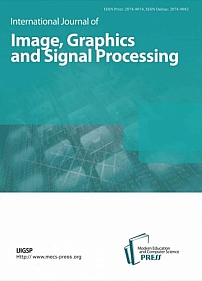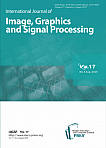International Journal of Image, Graphics and Signal Processing @ijigsp
International Journal of Image, Graphics and Signal Processing
International Journal of Image, Graphics and Signal Processing (IJIGSP) is a peer reviewed journal in the field of Image, Graphics and Signal Processing. The journal is published 12 issues per year by the MECS Publisher from 2012. All papers will be blind reviewed. Accepted papers will be available on line (free access) and in printed version. No publication fee.
JIGSP is publishing refereed, high quality original research papers in all areas of Image, Graphics and Signal Processing.
IJIGSP has been indexed by several world class databases: Google Scholar, Microsoft Academic Search, CrossRef, DOAJ, IndexCopernicus, INSPEC(IET), EBSCO, JournalSeek, ULRICH's Periodicals Directory, WordCat, Scirus, Academic Journals Database, Stanford University Libraries, Cornell University Library, UniSA Library, CNKI Scholar, ProQuest, J-Gate, ZDB, BASE, OhioLINK, iThenticate, Open Access Articles, Open Science Directory, National Science Library of Chinese Academy of Sciences, The HKU Scholars Hub, etc...
The journal publishes original papers in the field of Image, Graphics and Signal Processing which covers, but not limited to the following scope:
Neurophysiology image processing
Image quantification and image codes
Image reconstruction and image enhancement
Image segmentation and feature extraction
Image fusion and ultra resolution
Information hiding and digital watermarking
Content-based Image Information Retrieval
Video transmission and analysis
Remote sensing imagery processing and medicine imagery processing
Image processing in industry and agriculture
Artificial Intelligent System
Pattern Recognition
Data Mining and Knowledge Discovery
Pattern recognition
Graph and Image Processing
Computer Application Technology
Modern Education & Computer Science Press
Выпуски журнала
Статьи журнала
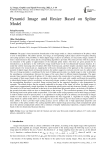
Pyramid Image and Resize Based on Spline Model
Статья научная
The paper is based around the formalization of the image model as a linear combination of B-splines, which is close to interpolation. The authors present, on average, its corresponding explicit aspects and low-frequency filtering and scaling operators. The possibility to obtain digital images scaled to an arbitrary, not necessarily integer, number of times is demonstrated in the article and the corresponding algorithm is provided. The article provides with the examples on estimation of the quality of approximation of the indicated spline model. Also there are given grounds for its introduction as an alternative to the well-known image model based on the two-dimensional Gaussian function. It is noted that with the increasing order, B-splines differ little from Gaussian, and their simpler calculation makes the spline model attractive for research and use. Applying the well-known formalization of the approach to the construction of a pyramid of digital images based on Gaussian functions, the authors suggest its extension onto the case of a spline model. The use of image pyramids is conditioned by the task of finding special points in a digital image in order to determine the unambiguous correspondence between the images of the same object in different digital photographs. The paper presents linear operators based on B-splines of 2-6 orders aimed at the construction of a pyramid, it also demonstrates an example of their usage. Based on the convolution of the raster with a mask with variable coefficients the possibility to obtain digital images scaled to an arbitrary, not necessarily integer, number of times is demonstrated in the article and the corresponding algorithm is provided. Image resizing based on the suggested algorithm is also demonstrated by examples. The authors believe that the research conducted in the paper in the future will allow for digital images to obtain more computationally simple algorithms for determining special points and their detectors. Results of paper: 1. The model of a DI has been formalized on the basis of two-dimensional polynomial splines, on the basis of B-splines of the second-sixth orders which are close to interpolation on the average. 2. The convolution operators of low-frequency DI filtering based on the spline model are presented. 3. Provided are the scaling operators used to build image pyramids, in order to further search for special points. 4. An algorithm for scaling the DI to an arbitrary, not necessarily an integer number of times based on a continuous spline approximation has been suggested. 5. Algorithm for scaling a digital image based on a spline model allows you to change the size of the image in any (not necessarily an integer) number of times, differs in that it provides high scaling accuracy and no artifacts due to high approximate properties and smoothness of the spline model;6. The scaling algorithm allows digital image processing at high computational speed due to the optimal computational scheme with a minimum of simpler mathematical operations, compared with models based on the two-dimensional Gaussian function.
Бесплатно
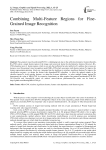
Combining Multi-Feature Regions for Fine-Grained Image Recognition
Статья научная
Fine-grained visual classification(FGVC) is challenging task duo to the subtle discriminative features.Recently, RA-CNN selects a single feature region of the image, and recursively learns the discriminative features. However, RA-CNN abandons most of feature regions, which is not only the inefficient but aslo ineffective.To address above issues,we design a noval fine-grained visual recognition model MRA-CNN,which associates multi-feature regions.To improve the feature representation,attention blocks are integrated into the backbone to reinforce significant features;To improve the classification accuracy, we design the feature scale dependent(FSD) algorithm to select the optimal outputs as the classifier inputs;To avoid missing features, we adopt the k-means algorithm to select multiple feature regions.We demonstrate the value of MRA-CNN by expensive experiments on three popular fine-grained benchmarks:CUB-200-2011,Cars196 and Aircrafts100 where we achieve state-of-the-art performance.Our codes can be found at https://github.com/dlearing/MRA-CNN.git.
Бесплатно
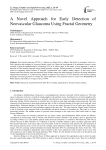
A Novel Approach for Early Detection of Neovascular Glaucoma Using Fractal Geometry
Статья научная
Neovascular glaucoma (NVG) is a human eye disease due to diabetes that leads to permanent vision loss. Early detection and treatment of it prevent further vision loss. Hence the development of an automated system is more essential to help the ophthalmologist in detecting NVG at an earlier stage. In this paper, a novel approach is used for detection of Neovascular glaucoma using fractal geometry concepts. Fractal geometry is a branch of mathematics. It is useful in computing fractal features of irregular, asymmetrical, and complex natural objects. In this work, fractal feature-based Neovascular glaucoma detection from fundus images has been proposed. It utilizes the image adjustment enhancement technique as a preprocessing method to improve the accuracy of NVG detection and the box-counting technique of Fractal geometry to estimate the fractal dimension. The proposed system is tested over MESSIDOR and KMC datasets and yields an average accuracy of 98%.
Бесплатно
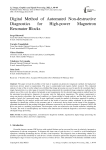
Digital Method of Automated Non-destructive Diagnostics for High-power Magnetron Resonator Blocks
Статья научная
The paper reveals the problem of the lack of standard non-destructive diagnostic methods for high-power microwave devices aimed at regeneration. The issue is understudied and requires further research. The conducted analysis of state of the art on the subject area exhibited that image processing was used to specify the examined object's target characteristics in a wide range of research. Having summarized the considered image comparison methods on the subject area of this work, the authors formulated several requirements for the selected image analysis method based on the automated non-destructive diagnosis of resonator units for high-power magnetrons. The primary requirement is using non-iterative algorithms; the second condition is a chosen method of image analysis, and the third option is the number of pixels for a processed image. It must significantly exceed the number of descriptors required for making a decision. Guided by the analysis results and based on the results of previous studies conducted by the authors, the algorithm for identifying a defect in the resonator unit of a microwave device based on the image of the frequency-azimuthal distribution for the probing field phase difference expressed by the Zernike moments is proposed. MATLAB R14a was used as a modeling environment. The descriptor vector was restricted to the Zernike moments, including the 7th order. The work is interdisciplinary and written at the intersection of technical diagnostics, microwave engineering, and digital image processing.
Бесплатно
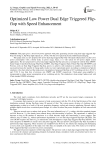
Optimized Low Power Dual Edge Triggered Flip-flop with Speed Enhancement
Статья научная
This paper gives a novel low-power approach with pulse generating circuits using dual edge triggered flip-flops. By doing so, flip-flop might operate at 1.2Volts, with the novel quick latch and conditional precharging. This paper aims at a new proposed low power dual edge triggered flip-flop with speed enhancement to achieve low power consumption with a shorter delay in power usage, hence, it is well suited for low-power digital system applications. The new proposed low power dual edge triggered flip-flop also aims at comparison with the three DETFF, Static Output Controlled Discharge Flip-Flop (SCDFF), Dual Edge Triggered Static Pulsed Flip-flop (DETSPFF), and Pervious work on Dual Edge Triggered flip-flop, proves to achieves with reduction in numbers of transistors in the stack and increases the number of charge-paths results in a faster operational speed. According to simulation on Spectre simulator, it has been observed that total power consumption of proposed flip flop at 0.67 switching activity is 30.16 % and 27.36 % less than that of previous arts DSPFF and SCDFF respectively. Clock-gated sense-amplifier is incorporated to reduce power consumption at low switching activity. The simulation is done using Cadence tool with 45nm standard CMOS technology.
Бесплатно

